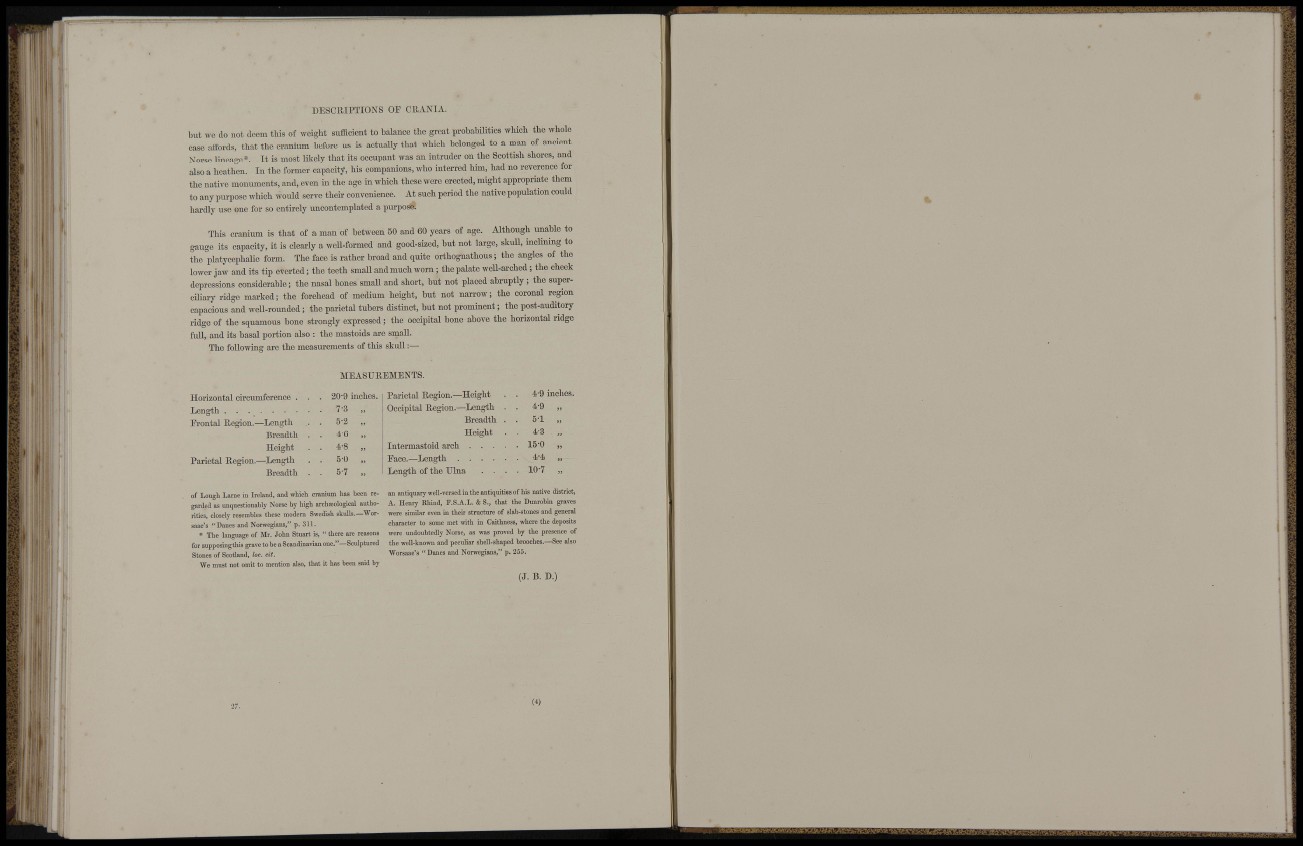
H I
' lli ll^üi I
; :ii
' .J if
DESCllIPTIONS OF CRANIA.
but wo do not deem this of weight sufficient to balance the great probabflitics which the whole
case affords, that the cranium before us is actually that which belonged to a man of ancient
Norse lineage*. It is most likely that its occupant was an intruder on the Scottish shores, and
also a heathen. In the former capacity, his companions, who interred him, had no reverence for
the native monimients, and, even in the age in which these were erected, might appropriate them
to any purpose which would serve their convenience. At such period the native population could
hardly use one for so entirely uncontemplated a purpose.
This cranium is that of a man of between 50 and 60 years of age. Although unable to
gauge its capacity, it is clearly a weU-formed and good-sized, but not large, skuU, inclining to
the platycephaUc form. The face is rather broad and quite orthognathous; the angles of the
lower jaw and its tip everted; the teeth small and much worn; the palate weU-arched ; the cheek
depressions considerable; the nasal bones small and short, but not placed abruptly ; the superciliary
ridge marked; the forehead of medium height, but not narrow; the coronal region
capacious and weU-rounded ; the parietal tubers distinct, but not prominent; the post-auditory
ridge of the squamous bone strongly expressed; the occipital bone above the horizontal ridge
fiiU, and its basal portion also : the mastoids are sniaH.
The following are the measurements of this skull:—
MEASUREMENTS.
Horizontal circumference .
Length
Erontal Region.—Length
Breadth
Height
Parietal Region.—Length
Breadth
20-9 inches.
7-3 „
5-2 „
4.'6 „
4-8 „
6-0 „
5-7 „
Parietal Region.—Height
Occipital Region.—Length
Breadth
Height
Intermastoid arch . . .
Eace.—Length . . . .
Length of the Ulna . .
of Lough Lame in Ireland, and which cranium has been regarded
as unquestionably Norse by high archieological authorities,
closely resembles these modern Swedish skulls.—Worsaae's
"Danes and Norwegians," p. 311.
* The language of Mr. John Stuart is, " there are reasons
for supposingthis grave to be a Seandinayian one."—Sculptured
Stones of Scotland, loc. cit.
We must not omit to mention also, that it has been said by
4-9 inches.
4-9 „
5-1 „
4-3 „
15-0 „
4-4 „
10-7 „
an antiquary well-versed in the antiquities of his native district,
A. Henry Bhind, F.S.A.L. & S., that the Dunrobin graves
were similar even in their structure of slab-stones and general
character to some met with in Caithness, where the deposits
were undoubtedly Norse, as was proved by the presence of
the well-known and peculiar shell-shaped brooches.—See also
Worsaae's "Danes and Norwegians," p. 255.
(J. B. D.)